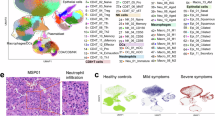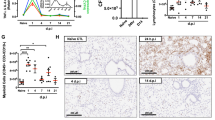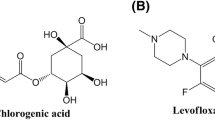Abstract
Chlamydophila pneumoniae alter the expression of Toll-like receptor (TLR) 4 in alveolar type II (ATII)-cells. Subsequently nuclear factor kappaB (NF-κB) is activated and tumor necrosis factor-α (TNF-α) and macrophage inflammatory protein 2 (MIP-2) are produced. Perfluorocarbons (PFC) are beneficial in animals with bacterial pneumonia and reduce production of TNF-α. Using isolated ATII-cells, it was studied whether PFC prevent C. pneumoniae-induced TNF-α and MIP-2 release and what the underlying pathway is. PF5080 preincubation prevented C. pneumoniae-induced secretion of TNF-α (43 ± 10 versus 661 ± 41 pg/mL) and MIP-2 (573 ± 41 versus 4786 ± 502 pg/mL). The C. pneumoniae-induced 2.2-fold increase of TNF-α Receptor 1 expression was reduced by PF5080. C. pneumoniae reduced cytoplasmatic IκBα (3.7 ± 0.3 versus 14 ± 1) and increased NF-κB p65 (31 ± 7.5 versus 3.6 ± 1.1) compared with control. PF5080 prevented NF-κB activation. TLR4 expression was 1.5-fold higher after C. pneumoniae incubation, but remained at control levels after PF5080 pretreatment. After 24 h of C. pneumoniae incubation, in 88 ± 6% of cells bacteria were found in the perinuclear region and in 50% of these cells bacteria adhered to cellular surface. After PF5080 preincubation, C. pneumoniae were in 32 ± 4% attached to and in 5 ± 1% internalized in ATII-cells. Since PF5080 was found in ATII-cell membranes, PF5080 effect could be explained by an alteration of the cellular membrane, preventing activation of the inflammatory cascade.
Similar content being viewed by others
Log in or create a free account to read this content
Gain free access to this article, as well as selected content from this journal and more on nature.com
or
Abbreviations
- ATII:
-
alveolar type II
- cHSP60:
-
chlamydial Heat Shock Protein 60
- CLSM:
-
confocal laser scanning microscopy
- MIP-2:
-
macrophage inflammatory protein 2
- NF-κB:
-
nuclear factor kappaB
- PFC:
-
perfluorocarbons
- TLR4:
-
Toll-like receptor 4
References
Hammerschlag MR 2003 Pneumonia due to Chlamydia pneumoniae in children: epidemiology, diagnosis, and treatment. Pediatr Pulmonol 36: 384–390
Jantos CA, Wienpahl B, Schiefer HG, Wagner F, Hegemann JH 1995 Infection with Chlamydia pneumoniae in infants and children with acute lower respiratory tract disease. Pediatr Infect Dis J 14: 117–122
Rupp J, Droemann D, Goldmann T, Zabel P, Solbach W, Vollmer E, Branscheid D, Dalhoff K, Maass M 2004 Alveolar epithelial cells type II are major target cells for C. pneumoniae in chronic but not in acute respiratory infection. FEMS Immunol Med Microbiol 41: 197–203
Boman J, Hammerschlag MR 2002 Chlamydia pneumoniae and atherosclerosis: critical assessment of diagnostic methods and relevance to treatment studies. Clin Microbiol Rev 15: 1–20
Branden E, Koyi H, Gnarpe J, Gnarpe H, Tornling G 2005 Chronic Chlamydia pneumoniae infection is a risk factor for the development of COPD. Respir Med 99: 20–26
Hammerschlag MR 2000 Chlamydia pneumoniae and the lung. Eur Respir J 16: 1001–1007
Wissel H, Schulz C, Rüdiger M, Krüll M, Stevens PA, Wauer RR 2003 Chlamydia C. pneumoniae affect surfactant trafficking and secretion due to changes of type II cell cytoskeleton. Am J Respir Cell Mol Biol 29: 303–313
Wissel H, Schulz C, Koehne P, Richter E, Maass M, Rudiger M 2005 Chalmydophila pneumoniae induces expression of TLR4 and release of TNFα and MIP-2 via an NF-κB pathway in rat type II pneumocytes. Respir Res 6: 51–
Akira S, Takeda K, Kaisho T 2001 Toll-like receptors critical proteins linking innate and acquired immunity. Nat Immunol 2: 675–680
Campbell LA, Nosaka T, Rosenfeld ME, Yaraei K, Kuo C 2005 Tumor necrosis factor alpha plays a role in the acceleration of atherosclerosis by Chlamydia pneumoniae in mice. Infect Immun 73: 3164–3165
Shaffer TH, Wolfson MR, Greenspan JS, Hoffman RE, Davis SL, Clark LC Jr 1996 Liquid ventilation in premature lambs: uptake, biodistribution and elimination of perfluorodecalin liquid. Reprod Fertil Dev 8: 409–416
von der Hardt K, Schoof E, Kandler MA, Dötsch J, Rascher W 2002 Aerosolized perfluorocarbon suppresses early pulmonary inflammatory response in a surfactant-depleted piglet model. Pediatr Res 51: 177–182
Bleyl JU, Ragaller M, Tschö U, Regner M, Kanzow M, Hübler M, Rasche S, Albrecht M 1999 Vaporized perfluorocarbon improves oxygenation and pulmonary function in an ovine model of acute respiratory distress syndrome. Anesthesiology 91: 461–469
Dickson EW, Heard SO, Chu B, Fraire A, Brueggemann A, Doern GV 1998 Partial liquid ventilation with perfluorocarbon in the treatment of rats with lethal pneumococcal pneumonia. Anesthesiology 88: 218–223
Rüdiger M, Some M, Jarstrand C, Calkovska A, Linderholm B, Robertson B, Herting E 2003 Influence of partial liquid ventilation on bacterial growth and alveolar expansion in newborn rabbits with group B-streptococcal pneumonia. Pediatr Res 54: 808–813
Koch T, Ragaller M, Haufe M, Hofer A, Grosser M, Albrecht DM, Kotzsch M, Luther T 2001 Perfluorohexane attenuates proinflammatory and procoagulatory response of activated monocytes and alveolar macrophages. Anesthesiology 94: 101–109
Thomassen MJ, Buhrow LT, Wiedemann HP 1997 Perflubron decreases inflammatory cytokine production by human alveolar macrophages. Crit Care Med 25: 2045–2047
Merz U, Klosterhalfen B, Häusler M, Kellinghaus M, Peschgens T, Hörnchen H 2002 Partial liquid ventilation reduces release of leukotriene B4 and interleukin-6 in bronchoalveolar lavage in surfactant-depleted newborn pigs. Pediatr Res 51: 183–189
Haeberle HA, Nesti F, Dietrich HJ, Gatalica Z, Garofalo RP 2002 Perflubron reduces lung inflammation in respiratory syncytial virus infection by inhibiting chemokine expression and nuclear factor-kB activation. Am J Respir Crit Care Med 165: 1433–1438
Kawamae K, Pristine G, Chiumello D, Tremblay LN, Slutsky A 2000 Partial liquid ventilation decreases serum tumor necrosis factor-a concentration in a rat aspiration lung injury model. Crit Care Med 28: 479–483
Colton DM, Hirschl RB, Johnson KJ, Till GO, Dean SB, Bartlett RH 1994 Neutrophil infiltration is reduced during partial perfluorocarbon liquid ventilation in the setting of lung injury. Surg Forum 1055: 668–670
Colton DM, Till GO, Johnson KJ, Dean SB, Bartlett RH, Hirschl RB 1998 Neutrophil accumulation is reduced during partial liquid ventilation. Crit Care Med 26: 1716–1724
Colton DM, Till GO, Johnson KJ, Gater JJ, Hirschl RB 1998 Partial liquid ventilation decreases albumin leak in the setting of acute lung injury. J Crit Care 13: 136–139
Baba A, Kim Y-K, Zhang H, Liu M, Slutsky AS 2000 Perfluorocarbon blocks tumor necrosis factor-α-induced interleukin-8 release from alveolar epithelial cells in vitro. Crit Care Med 28: 1113–1118
Varani J, Hirschl RB, Dame M, Johnson K 1996 Perfluorocarbon protects lung epithelial cells from neutrophil-mediated injury in an in vitro model of liquid ventilation therapy. Shock 6: 339–344
Haufe D, Luther T, Kotzsch M, Knels L, Koch T 2004 Perfluorocarbon attenuates response of concanavalin A-stimulated mononuclear blood cells without altering ligand-receptor interaction. Am J Physiol Lung Cell Mol Physiol 287: L210–L216
Obraztsov VV, Neslund G, Kornbrust E, Flaim S, Woods CM 2000 In vitro cellular effects of perfluorochemicals correlate with their lipid solubility. Am J Physiol Lung Mol Cell Physiol 278: L1018–L1024
Maass M, Harig U 1995 Evaluation of culture conditions used for isolation of Chlamydia pneumoniae. Am J Clin Pathol 103: 141–148
Altavilla D, Saitta A, Guarini S, Galeano M, Squadrito G, Cucinotta D, Santamaria LB, Mazzeo AT, Campo GM, Ferlito M, Minutoli L, Bazzani C, Bertolini A, Caputi AP, Squadrito F 2001 Oxidative stress causes nuclear factor-κB activation in acute hypovolemic hemorrhagic shock. Free Radic Biol Med 30: 1055–1066
Zhang DX, Zou AP, Li PL 2001 Adenosine diphosphate ribose dilates bovine coronary small arteries through apyrase- and 5′-nucleotidase-mediated metabolism. J Vasc Res 38: 64–72
Rüdiger M, Wissel H, Ochs M, Burkhardt W, Proquitté H, Wauer RR, Stevens P, Rüstow B 2003 Perfluorocarbons are taken up by isolated type II pneumocytes and influence its liquid synthesis and secretion. Crit Care Med 31: 1190–1196
Coombes BK, Mahony JB 2002 Identification of MEK- and phosphoinositide 3-kinase-dependent signaling as essential events during Chlamydia pneumoniae invasion of Hep2 cells. Cell Microbiol 4: 447–460
Wissel H, Müller T, Rüdiger M, Krüll M, Wauer RR 2005 Contact of Chlamydophila pneumoniae with type II cell triggers activation of calcium-mediated NF-κB pathway. Biochim Biophys Acta 1743: 37–48
Puolakkainen M, Kuo CC, Campbell LA 2005 Chlamydia pneumoniae uses the mannose 6-phosphate/insulin-like growth factor 2 receptor for infection of endothelial cells. Infect Immun 73: 4620–4625
Prebeck S, Kirschning C, Durr S, da Costa C, Donath B, Brand K, Redecke V, Wagner H, Miethke T 2001 Predominant role of toll-like receptor 2 versus 4 in Chlamydia pneumoniae-induced activation of dendritic cells. J Immunol 15: 3316–3323
Sasu S, LaVerda D, Qureshi N, Golenbock DT, Beasley D 2001 Chlamydia pneumoniae and chlamydial heat shock protein 60 stimulate proliferation of human vascular smooth muscle cells via toll-like receptor 4 and p44/p42 mitogen-activated protein kinase activation. Circ Res 89: 244–250
Costa CP, Kirschning CJ, Busch D, Durr S, Jennen L, Heinzmann U, Prebeck S, Wagner H, Miethke T 2002 Role of chlamydial heat shock protein 60 in the stimulation of innate immune cells by Chlamydia pneumoniae. Eur J Immunol 32: 2460–2470
Da Costa CU, Wantia N, Kirschning CJ, Busch DH, Rodriguez N, Wagner H, Miethke T 2004 Heat shock protein 60 from Chlamydia pneumoniae elicits an unusual set of inflammatory responses via Toll-like receptor 2 and 4 in vivo. Eur J Immunol 34: 2874–2884
Rüdiger M, Köpke U, Prösch S, Rauprich P, Wauer RR, Herting E 2001 Effects of perfluorocarbons and perfluorocarbons/surfactant-emulsions on growth and viability of group B streptococci and Escherichia coli. Crit Care Med 29: 1786–1791
Acknowledgements
The authors thank Ruth Herrmann and Silke Wilitzki (Clinic of Neonatology, Campus Charité Mitte, University Children's Hospital, Humboldt-University Berlin, Germany) Petra Klein (Institute of Biology, Department of Membrane Physiology, Humboldt University Berlin, Germany), and Anke Hellberg (Institute of Medical Microbiology and Hygiene, University of Luebeck, Luebeck, Germany) for technical assistance.
Author information
Authors and Affiliations
Corresponding author
Additional information
This study was supported by grants Wi 2074/1-1 from the Deutsche Forschungsgemeinschaft and the “Medizinischer Forschungsfonds Tirol.”
Rights and permissions
About this article
Cite this article
Wissel, H., Burkhardt, W., Rupp, J. et al. Perfluorocarbons Decrease Chlamydophila pneumoniae–Mediated Inflammatory Responses of Rat Type II Pneumocytes In Vitro. Pediatr Res 60, 264–269 (2006). https://doi.org/10.1203/01.pdr.0000233033.82664.91
Received:
Accepted:
Issue date:
DOI: https://doi.org/10.1203/01.pdr.0000233033.82664.91
This article is cited by
-
Cytoprotection of Perfluorocarbon on PMVECs In Vitro
Inflammation (2013)
-
Systemic Administration of FC-77 Dampens Ischemia–Reperfusion-Induced Acute Lung Injury in Rats
Inflammation (2013)
-
Alterations of alveolar type II cells and intraalveolar surfactant after bronchoalveolar lavage and perfluorocarbon ventilation. An electron microscopical and stereological study in the rat lung
Respiratory Research (2007)



